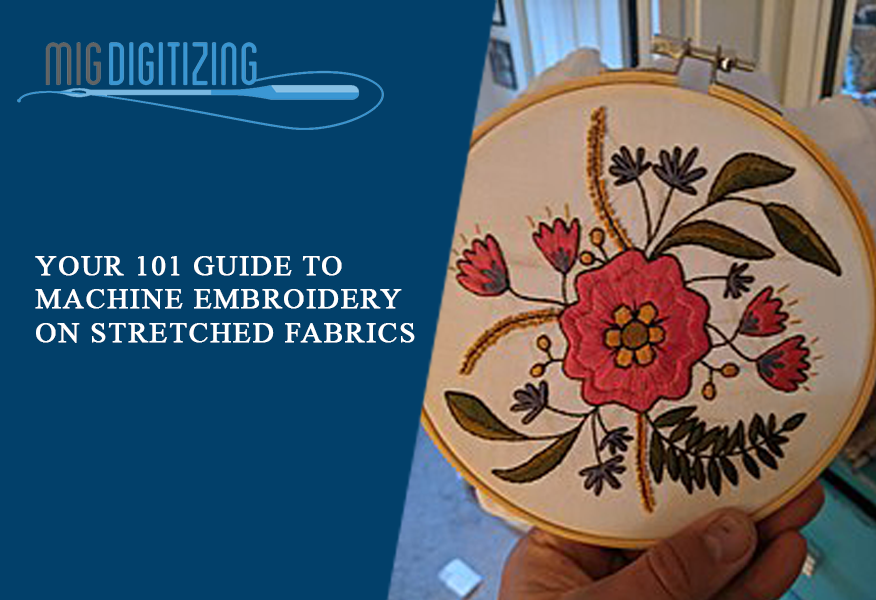
In this easy to read jiffy blog, we'll mention one among the foremost important embroidery digitizing processes that are machine embroidery on stretched fabrics.
Without further ado, let’s jump to the tips!
What are hoops?
Hoops consists of two rings and thus the material is stretched in between these rings and tightened with a screw. They're the foremost commonly used tool for stretching fabric when embroidering, be it by hand or by machine.
Simple Rules of hooping
-
Plastic hoops are good. they're smooth and easy to handle and washable. Don't mark fabric the utmost amount because of the wooden ones I feel.
-
Ensure that the ring you've isn't damaged, with no sharp things protruding from the wooden surface. Sand it or get a replacement one.
-
Do not stretch the fabric – A smooth surface is what you'd like
-
If you're stabilizing the fabric, hoop the fabric and thus the stabilizer together.
-
You should use a hoop that is 1-2 inches bigger all around than the design you're embroidering. Not bigger or smaller, ideally.
Tip: When logo digitizing on delicate fabric some people cover the frames with strips of fabric ( wind around the frame all around) so that the tight frames wouldn't mark the fabric.
It is necessary that you simply stretch the fabric when doing machine embroidery.
What are scroll frames or bars?
This is different from stretching fabric. The scroll bar or frame consists of two wooden scroll bars (which appear as if wooden dowels) and two spacers and tightening knobs. the fabric is attached to the scroll bars and thus the spacers keep the bars apart. the fabric should be bigger than the scroll frame you've. The scroll bars accompany stands also so that you're going to use it “hands-free”.
The fabric is predicated on a cloth already on the bar. A uniform type features a sticky material with no need for basting
Floor Standing frames have the frame clamped or rested on a stand. Table frames are often kept on the table – they hold fabric secure with rollers (scroll bars) at the very best and bottom. Rotating frames are used for doing large works.
So How does one Embroider On Stretched Fabrics?
Then you're embroidering on stretched fabrics, remember to always pre-wash the material before embroidering.
Fabrics like knits will stretch out when hooped. This will cause image distortion. To stop this problem, what you'll do isn't to hoop the material with the stabilizer. you'll hoop the stabilizer tightly. Then, spray the stabilizer with a short-lived spray adhesive.
Also, check if there are any wrinkles within the fabric and take them away. you'll use the perimeter-baste function to guard the material against the stabilizer. it'll aid within the placement of it at an equivalent time.
Get the acceptable Material
However, it depends on the embroidery design as discussed above.
This will help to stop any damage during the method.
You can take a rounded tip needle-like of a ballpoint. On the opposite hand, the heavyweight knit requires a needle size of 80/12.
Making The Last Finishes
This is the last step. Once you're through with all the technical stuff, it's time for a few finishing and makes your embroidery artwork look amazing.
Make Sure you select the proper Design
When you are embroidering on material like knitting, it's important to settle on an open and airy design. it'll allow the material to drape well after it's stitched.
The designs will look distorting and puckering. it's always a wise step to avoid areas that are large and have continuous embroidery.
This can assist you tons once you are performing machine embroidery.
Conclusion
This is all you would like to understand about doing machine embroidery on stretched fabrics. The method of creating embroidery designs on stretched fabric isn't difficult. If you've read this far, then you'll be easily ready to do the work. Just follow the following pointers and begin making those amazing eye-catching designs on stretched fabrics you usually wish to form.
If you continue to have any questions on stretched fabrics on machine embroidery or anything associated with custom embroidery digitizing, then you'll contact us at Migdigitizing. we'll be happy to help you together with your queries.



